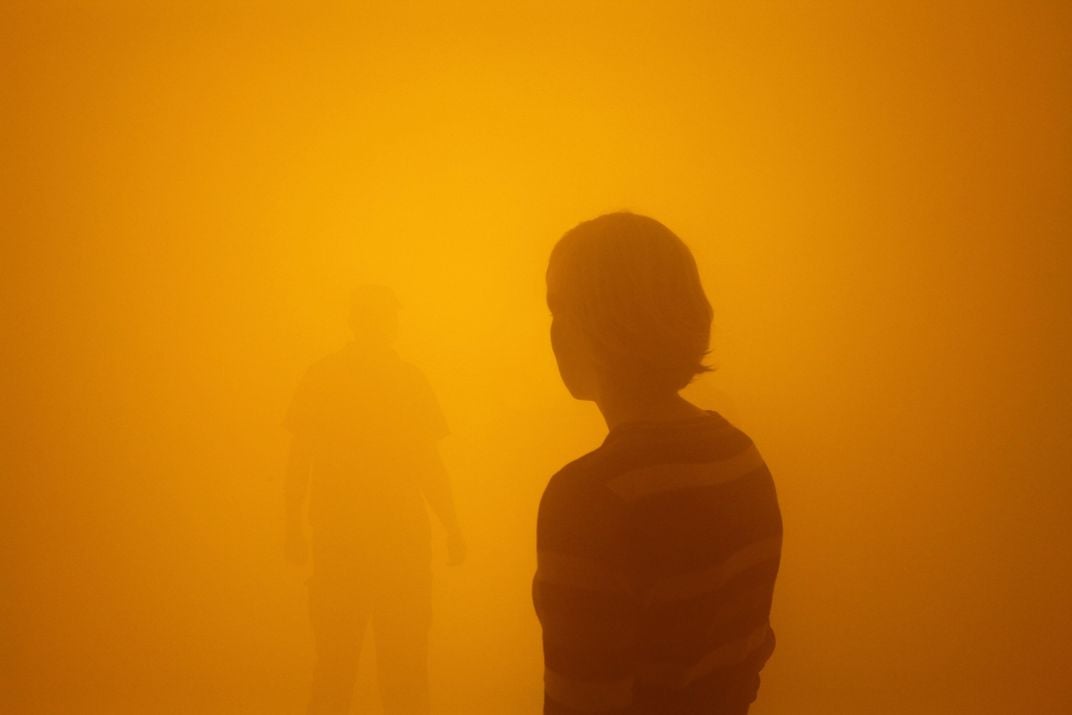Consider the Nature of Perception at Olafur Eliasson’s New Show
Tate Modern retrospective features some 40 works pulled from the artist’s decades-long career
/https://tf-cmsv2-smithsonianmag-media.s3.amazonaws.com/filer/a9/10/a9108d91-0cb8-4745-ae4d-b513319f1966/olafur_eliasson_the_structural_evolution_project_2004.jpg)
In 2003, Olafur Eliasson—with the help of 200 mono-frequency lights, projection and mirror foils, haze machines, aluminum, and scaffolding—recreated the sky, complete with a blazing orange sun. Nothing like it had been seen before, and some 2 million visitors flocked to Tate Modern’s Turbine Hall to take in the sight.
Now, nearly two decades after that triumphant Tate debut, Eliasson returns to the museum with an ambitious new work reflecting on humanity’s relationship with nature, particularly in relation to climate change.
Titled Olafur Eliasson: In Real Life, it has a much wider scope than “Weather Project,” featuring around 40 different works made over the Icelandic-Danish artist’s 30-year career.
According to the Guardian’s Mark Brown, In Real Life revolves around an array of interactive art. There’s a 128-foot-long fog corridor, a wall of reindeer moss imported from Finland, a 36-foot waterfall and an intriguing Lego station that uses a ton of white bricks. The creations that will come out of those Legos, according to Eliasson, strive to encapsulate visions of the future, evolving as more people change the structures created by those who preceded them.
As a whole, the exhibition bears all the hallmarks of Eliasson’s signature style: among others, ambition in scale, an environmental focus and an emphasis on sensory experience. As Jill Lawless writes for the Associated Press, visitors don’t simply view the retrospective; they also “feel, smell and taste it.”

In a press release, Tate identifies one of Eliasson’s key goals as prompting viewers to consider the nature of perception. The yellow fog corridor, for example, disorients those making their way through the passage by creating the illusion of a purplish-blue light at the end of the tunnel. In actuality, Mark Hudson explains in the Telegraph, the complementary color is simply an after-image of the yellow mist—it’s “as though you’ve [gotten] physically lost inside the processes of color perception.”
According to the AP’s Lawless, In Real Life’s activist overtones are most apparent in the show’s final room, a space dedicated to Eliasson’s work beyond art.
In the room, dubbed the “Expanded Studio,” a low-cost solar lamp designed to provide power to those living off the grid takes the stage alongside “Ice Watch,” a recurring installation that has previously found the artist adorning city streets with chunks of rapidly melting ice imported straight from a Greenland fjord. As Eliasson told the Guardian’s Tim Jonze in a December 2018 interview, “In order to create the massive behavioral change needed [to fight global warming], we have to emotionalize that data, make it physically tangible.”
To Eliasson, art and activism are one and the same.
“When you step into a museum you don't step out of the real world,” he tells Lawless. “It's like seeing reality in higher definition.”
Olafur Eliasson: In Real Life is on view at Tate Modern in London through January 5, 2020.
/https://tf-cmsv2-smithsonianmag-media.s3.amazonaws.com/accounts/headshot/mellon.png)
/https://tf-cmsv2-smithsonianmag-media.s3.amazonaws.com/accounts/headshot/mellon.png)